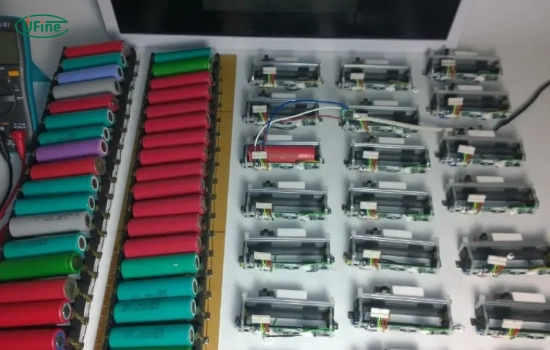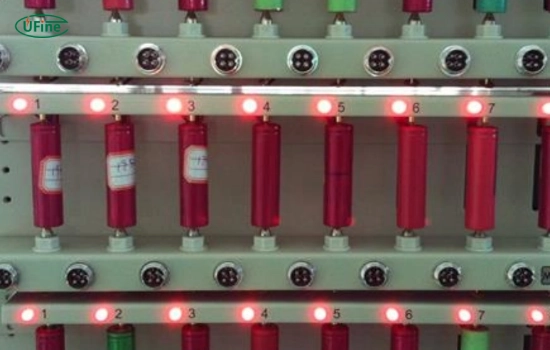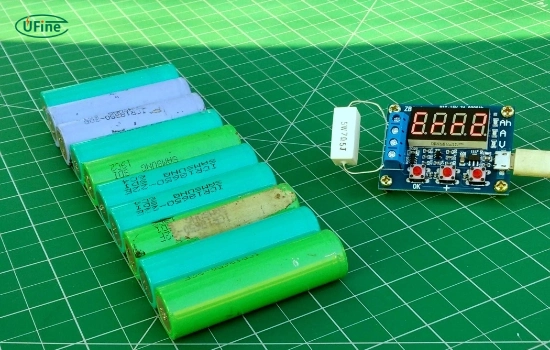
- Part 1. Importance of testing battery health
- Part 2. What is a 18650 battery tester and how to use it?
- Part 3. Methods to test 18650 battery health
- Part 4. How to test 18650 battery with a multimeter (no tester)
- Part 5. Interpreting 18650 battery health test results
- Part 6. FAQs about testing 18650 battery health
- Part 6. 2025 Update: Smart testing trends
- Part 7. 18650 battery testing safety & proper disposal
The 18650 battery health test guarantees reliability and performance across various applications. From powering portable electronics to sustaining renewable energy systems, understanding and evaluating the health of these batteries holds immense significance. This article delves into comprehensive methods for conducting the 18650 battery health test, shedding light on their condition and efficiency for optimal functionality.
- Rest the cell 1–2 h, then measure open‑circuit voltage (OCV).
- Check internal resistance (IR) with a tester; lower is better.
- Run a controlled discharge to cut‑off (≈2.8–3.0 V) to get capacity (mAh).
- Compare: ≥80–90% of rated mAh with stable IR ≈ healthy.
- If OCV < 2.5 V or IR abnormally high → replace safely.
Part 1. Importance of testing battery health
Assessing the health of 18650 batteries is fundamental, ensuring sustained performance, durability, and safety across many applications.
- Optimized Performance: Testing the health of 18650 batteries enables users to gauge their current capacity and efficiency. This data allows for the selection of batteries best suited for specific devices or systems, ensuring optimal performance.
- Safety Assurance: Batteries with deteriorating health pose safety risks, including overheating or leakage. Regular testing helps identify potential hazards, enabling preventive measures to be taken before any safety concerns arise.
- Economic Viability: Understanding the health of 18650 batteries aids in maximizing their lifespan. Identifying and replacing degraded batteries promptly prevents unnecessary expenses due to unexpected failures or inefficiencies.
- Reliable Power Sources: In various industries, such as electronics, automotive, and renewable energy, reliable power sources are crucial. Testing battery health ensures that these power sources remain dependable, supporting continuous operations.
- Environmental Impact: Proper assessment and maintenance of battery health contribute to sustainable practices. It minimizes unnecessary waste by prolonging the batteries’ life and reducing the disposal frequency.
Using a dedicated 18650 battery tester can reduce replacement costs by 35% through early fault detection. Industrial users report 40% fewer system failures with quarterly tester-based checks.
Part 2. What is a 18650 battery tester and how to use it?
A dedicated 18650 battery tester is the most efficient tool to evaluate battery health. Here’s how to use it:
- Step-by-step testing: Insert the battery → Select the desired test mode (e.g., capacity check) → Review voltage, capacity, and internal resistance results on the LCD screen.
Buying guide: what to look for in a 18650 battery tester
- Accuracy: Ensure ±1% voltage measurement error for reliable results.
- Functions: Must test open-circuit voltage (OCV), full discharge capacity (mAh), internal resistance (IR, mΩ), cycle life, and allow adjustable charge/discharge current.
- Compatibility: Fit 18650/21700/26650 cells, including protected cells of longer length.
- Thermal management & calibration: Look for testers with airflow or temperature monitoring; self-calibration or factory calibration certificates are a plus.
- Data export: USB/Bluetooth to record voltage–time and capacity curves (helpful for long-term health tracking).
- Safety features: Over-temperature, reverse polarity, and short-circuit protection are essential.
- Trusted brands: XTAR, OPUS, SkyRC, LiitoKala are widely recommended.
Best 18650 Battery Testers (home & lab)
| Model | Slots | Max Charge/Discharge | IR Test | Data Export | Fits 21700 | Best For |
|---|---|---|---|---|---|---|
| XTAR VC4SL | 4 | 1A / — | Yes | — | Yes | Home quick check |
| XTAR VC8 | 8 | 1A / — | Yes | — | Yes | Batch OCV/IR |
| LiitoKala Lii‑500/Lii‑600 | 4 | Up to 1A / 0.5A | Yes | — | Depends | Budget capacity test |
| OPUS BT‑C3100 | 4 | Up to 2A / 1A | Yes | — | Yes | Hobby & analysis |
| SkyRC MC3000 | 4 | Programmable | Yes | Bluetooth/App | Yes | Advanced/precise |
Part 3. Methods to test 18650 battery health
Voltage Measurement
Measure open-circuit voltage (OCV) to screen cell condition. Insert the battery into a tester or use a multimeter, ensuring it has rested at room temperature for at least one hour for accuracy. Healthy cells typically show 3.0–4.2 V when resting. Voltage <2.5 V usually indicates deep discharge and may be unsafe to reuse.
Pro Tip: Advanced testers like the Opus BT-C3100 display voltage fluctuations during discharge tests, which can be a sign of degradation.
Capacity Testing
Capacity testing determines how much energy a cell can store and deliver.
- Setup: Use a battery analyzer or tester capable of performing controlled discharge cycles.
- Charge: Fully charge the cell to 4.20 V before starting the test.
- Discharge: Discharge at a constant current (e.g., 0.2C) to a safe cut-off (2.8–3.0 V).
- Record: Note the discharged capacity and compare to the nominal rating. Loss >20% indicates aging; replace critical cells <80% of rated mAh.
- Multiple cycles: Repeat several cycles to observe capacity retention trends.
Internal Resistance Testing
High internal resistance (IR) reduces power delivery and increases heat.
- Equipment: Use a battery tester or resistance meter designed for 18650 cells.
- Procedure: Test on a fully charged battery for consistency. IR should be compared against baseline values when new.
- Interpret: A 30–50% rise in IR means the cell is aging; double baseline IR usually indicates it should be retired.
Charge and Discharge Cycling
Multiple charge–discharge cycles test long-term stability and health.
- Fully charge the battery and record initial parameters.
- Discharge to 20–30% of capacity, then recharge to full.
- Repeat several cycles while monitoring voltage, capacity, and temperature.
- Look for consistent declines in capacity or voltage stability as a sign of deterioration.
Part 4. How to test 18650 battery with a multimeter (no tester)
What you need: digital multimeter, known load (5–10 Ω 10W resistor), timer, insulated leads, and a fire-safe surface.
Step 1 – Voltage & basic screening
- Let the cell rest 1–2 h after charge or discharge.
- Measure open-circuit voltage (OCV): <2.5 V → do not use; 2.5–3.0 V → charge slowly and re-check; 3.0–4.2 V → proceed.
Step 2 – Approximate internal resistance
- Measure voltage at no load (
V0). - Connect load; measure loaded voltage (
V1) and current (I). - Estimate
IR ≈ (V0 − V1) / I(Ω → mΩ). Lower IR is healthier.
Step 3 – Capacity estimate (mAh)
- Fully charge the cell to 4.20 V, rest 30–60 min.
- Discharge with constant load to 2.8–3.0 V cutoff; record time
t(hours). - Calculate
mAh = I × t × 1000.
Part 5. Interpreting 18650 battery health test results
Voltage Measurement Analysis (updated)
- Voltage (resting): 3.0–4.2 V is normal; fully charged should be ~4.20 V ±0.05 V.
- Capacity: ≥80–90% of rated capacity usually means good health; replace critical cells <80%.
- Internal Resistance (IR): Compare to baseline. +30–50% rise requires attention; double baseline → replace.
- Self-discharge: Significant voltage loss over 7–14 days resting indicates possible leakage or micro-short.
Interpreting test results is crucial for understanding 18650 battery performance and safety. Each parameter offers a different perspective on battery health:
Capacity Testing Evaluation
Compare the actual capacity measured during discharge tests against the battery’s rated capacity. A healthy cell should be close to its nominal value. A 20% loss (e.g., 3000 mAh → 2400 mAh) indicates noticeable degradation; for critical applications, replace cells that have lost more than 30% capacity.
Internal Resistance Assessment
Low internal resistance ensures efficient power delivery. Rising IR means increasing losses and possible aging. If IR doubles compared to the baseline value, the cell should be replaced.
Charge and Discharge Cycling Observations
Track capacity retention, voltage stability, and irregularities across multiple charge–discharge cycles. A consistent decline in performance over cycles signals aging or damage.
Comparative Analysis & Pattern Identification
Compare current test data with initial results or industry benchmarks. Look for consistent downward trends in capacity or voltage over time, as these patterns indicate progressive degradation.
Part 6. FAQs about testing 18650 battery health
What is a 18650 battery tester?
A 18650 battery tester is a device that runs controlled charge and discharge cycles to measure capacity (mAh), checks open-circuit voltage, and evaluates internal resistance (mΩ) for health grading.
What are the signs of a declining 18650 battery?
Common indicators include shorter runtime, faster voltage drop under load, higher internal resistance, abnormal heating, and increased self-discharge during storage.
What voltage is considered empty for a 18650 battery?
Most devices cut off at 2.8–3.0 V to protect the cell. Discharging below 2.5 V can cause permanent damage and should be avoided.
Can I test capacity with just a multimeter?
Yes. Use a known resistor as a load and time the discharge to 2.8–3.0 V. Capacity (mAh) = current (A) × hours × 1000.
How often should I test 18650 battery health?
Test every 3–6 months or every 100 cycles. For mission-critical devices, quarterly testing and maintaining baseline data is recommended.
What is the best 18650 battery tester for home use?
XTAR VC4SL or VC8 are good for quick voltage and internal resistance checks. For advanced diagnostics, the SkyRC MC3000 offers full programmability and data export.
Can battery testers revive dead cells?
No. Battery testers only diagnose cells. Any 18650 cell with OCV <2.5 V, doubled internal resistance, or severe swelling should be replaced immediately.
Part 6. 2025 Update: Smart testing trends
The latest generation of 18650 battery testers now integrate AI-powered diagnostics. These tools can detect early warning signs such as microscopic dendrite growth and abnormal internal resistance shifts much faster than traditional testers, helping users replace failing cells before they become hazardous.
Examples include new programmable models from brands like SkyRC and OPUS, which offer data logging, predictive health scoring, and improved calibration features.
Part 7. 18650 battery testing safety & proper disposal
- Use a fire-resistant container and a non-flammable surface for all tests; never leave cells unattended.
- Immediately stop and isolate the cell if you notice swelling, unusual odor, heat, or leakage.
- Recycle batteries through authorized e-waste facilities according to local regulations; never dispose of them in household trash.
- For battery packs, always match cells by capacity and internal resistance and use proper balancing techniques.
Related Tags:
More Articles

Why Do Batteries Use Distilled Water?
Find out how distilled water works in batteries, which batteries need it, how to refill properly, and why tap water should be avoided.
What Battery Do You Need for a Quad?
Discover the best battery for a quad: voltage, size chart, lifespan, replacement steps, and common issues. Everything ATV riders need to know.
What Does a Battery Kill Switch Do and Should You Install One?
Discover if battery kill switches work, where to install them, and their drawbacks. A simple guide for wiring, safety, and reducing battery drain.
A Complete Guide to the Best Batteries for Flashlights
Discover the best batteries for flashlights: alkaline, lithium, NiMH & rechargeable options. Tips for performance and maintenance.
Graphene Battery vs Lithium Battery: Which is Better?
Compare graphene battery vs lithium battery in energy density, charging speed, lifespan, cost, and EV applications. Learn which battery leads in 2025.





